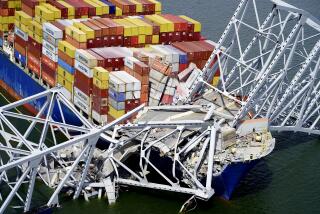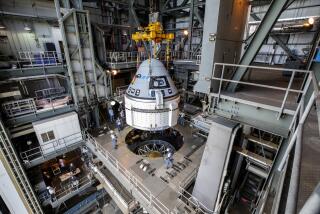Osprey Had Record of Mechanical Malfunction
WASHINGTON — The Marine Corps’ troubled Osprey aircraft, under intense scrutiny because of four fatal crashes, also experienced a series of previously undisclosed mechanical failures over the last 2 1/2 years, military officials have told a blue-ribbon study panel.
Among the seven incidents were three major hydraulic leaks, two of which caused engine fires, the panel was told in closed session last month by officials from the U.S. Naval Safety Center. Another incident involved the failure of a special drive shaft that is required for the aircraft to continue flying when one engine fails.
The mechanical failures raise new questions about the innovative hybrid plane, especially about its complex and delicate hydraulic system. Although none of the seven incidents resulted in a crash, analysts said several easily could have caused an MV-22 Osprey to go down.
Taken together with the four fatal crashes, one of which was attributed to a hydraulic failure, the incidents suggest that the Osprey’s problems are more serious than those experienced by other military aircraft during development and that its safety record is worse than previously disclosed. The new disclosures come at a particularly bad time for the Marines because Bush administration officials have declared that they are looking for major procurement programs to cut.
Documents summarizing the Naval Safety Center’s report to the blue-ribbon panel were provided to The Times. The Marines were not required to publicly disclose the mishaps. Some of the newly disclosed incidents “look like accidents waiting to happen,” said Michael Vickers, an analyst at the Center for Strategic and Budgetary Assessments, a nonpartisan think tank in Washington.
Philip E. Coyle, who retired last month as the Pentagon’s top weapons tester, said that the incidents reflect the “unsatisfactory reliability and maintainability” of the Osprey, and that some of the mishaps “represent reliability failures with clear safety implications.”
The Osprey has been the Marines’ top acquisition priority because its tilting rotors enable the craft to take off and land like a helicopter and speed across long distances like an airplane. It is manufactured by Bell Helicopter Textron of Fort Worth and Boeing Helicopters of Ridley Township, Pa.
But the $40-billion procurement program has come under fire because of a continuing series of accidents that have killed 30 people since 1991. The Pentagon convened the blue-ribbon commission in December to conduct a broad reassessment of the program shortly after the last Osprey crash, which occurred Dec. 11 and killed four Marines. The Osprey fleet has been grounded since that crash.
Defense analysts said the program appears increasingly vulnerable. Attention has focused on two issues: whether the plane is unstable during rapid descents and whether it has a trouble-prone hydraulic system.
The hydraulic system, which controls the movement of many of an aircraft’s moving parts, has been a concern for years. According to the Marines, it was a key factor in the December crash.
On the Osprey, the hydraulic system has a bigger job than on some other planes, because it is used to shift the heavy rotors from horizontal to vertical position during flight.
The Osprey’s designers chose a system that operates at a pressure of 5,000 pounds per square inch, compared with a traditional range of 2,000 to 3,000 pounds per square inch.
The higher pressure allowed designers to use lighter and smaller parts, experts said. But it also meant that the planes would be more prone to leaks and require more maintenance.
During the plane’s operational testing in 1999 and 2000, such leaks were the largest single source of problems, Marine officials have reported.
The Naval Safety Center reported that in one accident, on Feb. 2, 2000, hydraulic fluid leaked into the housing--called a nacelle--that surrounds the engine and ignited a fire.
In another incident, on Oct. 21, 1998, a hydraulic line burst, setting off another fire, the center reported.
On Oct. 18, 1998, a weld joint on another Osprey failed, spraying hydraulic fluid throughout the nacelle and engine compartments and causing the pilots to abort the flight, the Navy report said. The incident did not cause a fire, but the engine emitted a cloud of smoke.
Retired Air Force Lt. Gen. Richard Burpee, an aviation analyst, said high-pressure hydraulic systems often have been a source of trouble for aircraft designers because of the strain they put on hoses and other parts. “Every aircraft that has had pressure over 3,000 [pounds per square inch] had had problems,” he said.
Also significant, analysts said, was the failure of one Osprey’s “interconnecting drive shaft,” which took place during a flight on Aug. 24, 2000. The drive shaft is critical because if one engine fails, the power from the other engine can be transferred through the shaft to keep the rotor turning and the aircraft aloft.
The failure of the drive shaft “is a serious red flag for me,” said Christopher Hellman, analyst at the Center for Defense Information, which advocates reductions in defense spending. “That could be catastrophic.”
The document summarizing the presentation, made to the blue-ribbon panel by Navy Rear Adm. Frank M. “Skip” Dirren, did not provide extensive details of the mishap. Safety center officials were unavailable Monday to elaborate, a Navy spokeswoman said.
The Naval Safety Center reported two other incidents, on June 10 and June 24, 2000, in which pieces of rotor flew off aircraft. While it is not unusual for military aircraft to lose small pieces in flight, an incident involving the rotor can cause a weight imbalance that could lead to shaking, bouncing and other aerodynamic problems, analysts said.
Lt. David Nevers, a Marine Corps spokesman, said Marine officials are keeping an open mind about the plane’s shortcomings as the Pentagon blue-ribbon panel and two other investigations continue.
The performance of the hydraulic system “is an issue that has been raised,” he acknowledged.
At the same time, Nevers said, it is to be expected that engineering problems will come to light in a new airplane’s development stage. He said engineers already have found a solution for the two hydraulic leaks that occurred in October 1998.
While the Marines “recognize that there are questions that need to be answered . . . ,” Nevers said, “we are confident that this is the right aircraft for the Marine Corps.”
Coyle, the former weapons tester, said the incidents raise concern.
They are “representative of the unsatisfactory reliability and maintainability which caused my office to rate the V-22 Osprey as unsuitable last November,” he said in a statement.
More to Read
Inside the business of entertainment
The Wide Shot brings you news, analysis and insights on everything from streaming wars to production — and what it all means for the future.
You may occasionally receive promotional content from the Los Angeles Times.











